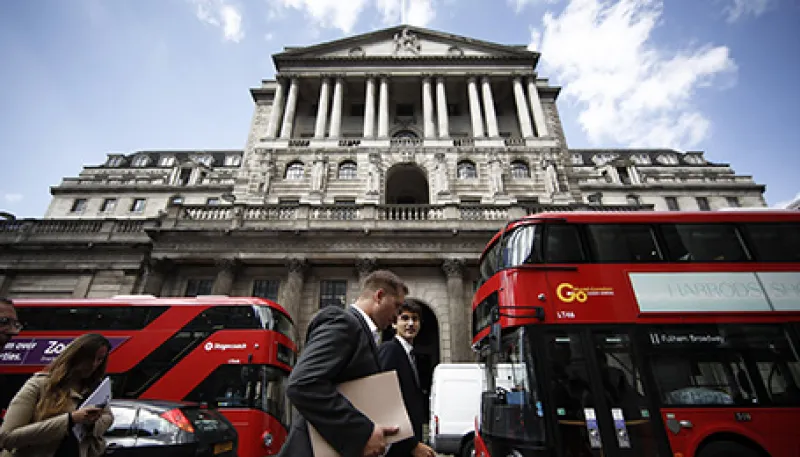For months investors in U.K. banks have been bracing themselves for the imposition of still higher capital requirements from the country’s regulators. But when the Bank of England finally announced the introduction of the new leverage ratio for the banks on Friday, long-disappointed investors in bank shares cheered, pushing up Barclays’ share price by 8.2 percent on the day and the Royal Bank of Scotland’s by 6.2 percent.
In part, the October 31 surge reflected the fact that the new leverage charge will be lower than many analysts had feared. Perhaps more important, though, is the robust health of the banks. The five major U.K. lenders — Barclays, RBS, Lloyds Banking Group, HSBC Holdings and Standard Chartered — have reached an important milestone in their long recovery: All now have higher capital levels than they did before the financial crisis. Retail banking operations have returned to strong profitability, buoyed by a resurgent U.K. economy, boosting return on equity.
“Animal spirits are back,” says Thomas Moore, fund manager for the U.K. Equity Income Unconstrained Fund at Standard Life Investments in Edinburgh, which has holdings of undisclosed size in U.K. banks. “Core profitability in retail and business banking is high and sustainably high,” in significant part because the U.K. economy has been growing at 3 percent this year, the fastest pace in the developed world, he adds.
The improving health and prospects for the Big Five led Richard McCarthy, U.K. head of banking at KPMG in London, to declare in a September report that banks have “turned a corner” on their way to full recovery from the financial crisis — although each of the banks is at a different stage on the path.
For some banks, it has been a considerable transformation since the fall of 2008, when the U.K. government had to inject £37 billion ($59 billion) in capital to bail out RBS, Lloyds TSB Group and HBOS to avert a financial sector collapse, effectively nationalizing them in the process. (Lloyds acquired HBOS as part of the rescue.) The tab eventually rose to almost £66 billion; the government still owns 80 percent of RBS and 25 percent of Lloyds.
Analysts are touting the banks’ success in building capital to meet regulatory requirements. “Using tangible equity as a share of net assets, the big U.K. banks hold 60 percent more capital against the balance sheet than they did going into 2007,” says Chirantan Barua, senior research analyst for U.K. banks at Sanford C. Bernstein in London. “The U.K. banks now have almost as much capital as U.S. banks — and in some cases more,” he says. “For example, Barclays actually has more capital than Morgan Stanley,” 4.7 percent to 4.5 percent, respectively, tangible equity to net assets. “And U.K. banks hold significantly more capital than Europe,” he adds, pointing out, for example, that Deutsche Bank’s tangible equity is at 3.3 percent of net assets.
The capital-generating engine of economic growth and retail banking profitability are expected to continue over the next two years. “Every bank in the U.K. in retail banking — which is mortgages and current accounts, and personal loans and credit cards — makes an ROE of 25 to 30 percent — it’s very high,” says Justin Bisseker, European banks analyst at Schroders in London.
Over the next 12 months, Barua sees significant upside for RBS, HSBC and Lloyds, predicting that share prices will rise between 25 and 34 percent. RBS has been the star performer so far this year, rising 17.6 percent since the end of 2013 to reach £388 on October 31. Shares of the other banks continue to languish in negative territory, even after Friday’s bump. Lloyds was down 2.1 percent year-to-date, HSBC 7.4 percent, Barclays 8.9 percent and Standard Chartered a hefty 30.4 percent.
The improving economy has allowed banks to do write-backs and recoveries from loan-loss reserves, helped along by a recovery in U.K. and Irish home prices. And as Lloyds winds down its strategy, in place since at least 2011, of gradually selling off troubled assets, investors are bidding up the prices of these assets, according to Moore.
Skeptics worry that improving capital levels mask underlying problems that banks and regulators refuse to properly recognize. “We don’t know how many loans within U.K. banks are duds, nonperformers, and how that then affects the quality of capital,” says Tom Elliott, international investment strategist at deVere Group, a financial consultancy based in Zurich. The lack of transparency at banks makes it difficult to judge, he adds.
U.K. banks also face headwinds. High capital levels have made investment banking operations increasingly less profitable and a drag on overall income at RBS and Barclays. The new leverage charge will up the ante. The Prudential Regulation Authority, the central bank arm that regulates and supervises banks, announced on October 31 that the big banks would need to hold an additional capital buffer because of the systemic risks they pose, lifting their leverage ratio to 4.05 percent. An additional countercyclical buffer, meant to pile up extra capital during boom times, could lift their leverage ratio to as high as 4.95 percent. Banks have until 2019 to meet the standard.
Some analysts had feared the central bank would set the leverage ratio at 5 percent or more. Morgan Stanley analysts Chris Manners and Fiona Simpson have found that the five largest U.K. banks could manage a 5 percent leverage ratio if given until 2017. The five banks collectively would fall £46 billion short of meeting a 5 percent ratio, the analysts calculated in a September note. At the end of September, Barclays’s 3.5 percent leverage ratio was the lowest of the major U.K. banks. Lloyds had the highest, 4.7 percent, whereas RBS had a ratio of 4.3 percent.
Higher leverage ratios will further reduce profitability in investment banking. Current capital requirements have already trimmed investment banking margins to wafer-thin levels, according to Bisseker. Barclays reported a 39 percent drop in pretax profit in its investment banking division in the third quarter. “The amount of capital you have to put behind that balance sheet is absolutely enormous compared with the amount of capital you had to put behind that balance sheet in 2006 and 2007,” says Bisseker. Trading positions, deals and activities put in place in the past that depended on high leverage for their profitability will remain a drag on earnings to the extent banks cannot exit from them, he adds.
The other big challenge is calculating the potential for additional fines, penalties and future civil litigation awards against banks for past misconduct, such as efforts to fix Libor, says McCarthy at KPMG. “I think the hope is that while other things may come through, we are looking at less of a focus on the sins of the past, because the past is starting to look like rather a long time ago, and more about how we build the bank of the future,” he says. And yet the fines keep coming. On October 28 Lloyds Banking Group was hit with a £900 million charge for misselling payment protection insurance, in instances like prolonged illness or unemployment, to people who did not need it or would not qualify to collect any claims, bringing the bank’s cost for its PPI misconduct to a hefty £11.3 billion. On October 30 Barclays set aside £500 million to cover potential penalties from allegations of price fixing in foreign exchange.
U.K. banks also face a Bank of England stress test, results of which will be announced December 16, that will assess how banks would fare if home prices fall 35 percent and interest rates jump to 6 percent. Executives at Lloyds are hoping the bank will get a passing grade so it can resume paying dividends for the first time since the crisis.
For investors, improved profitability and financial strength at U.K. banks are so far a story without a proper ending. “The fly in the ointment,” says Moore, is that bank shareholders have not fully shared in the recovery. “And that’s very frustrating.”
Moore expects that fundamental improvements in profits and capital at U.K. banks will, in time, be better reflected in their share prices.
Get more on banking .






